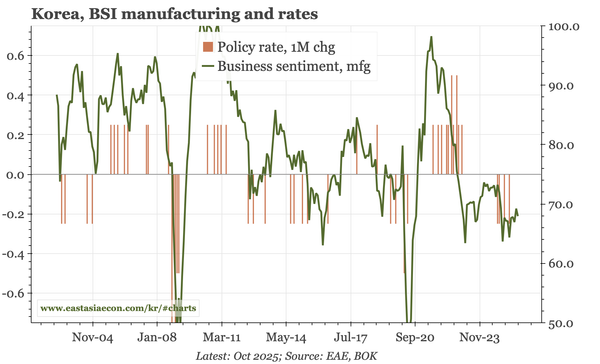Korea – household offshore equity buying and the KRW

Global factors like US rates and JPY weakness are dragging down the KRW. But there are also local drivers, particularly Korea's big buying of overseas equities. For both the NPS and households, I would expect that to slow, with the reversal likely to be sharp if global markets really sell off.
Korea – watching semi export prices

Import prices are rising, but not by enough to think upstream inflation is about to explode. More interesting are export prices. Auto export prices aren't rebounding. By contrast, semiconductor export prices seem to be gaining upwards momentum – which is important given the rise in spot DRAM prices.
Korea – "financial dominance"

With October meeting minutes, export and labour market data, there's enough to review the outlook for Korea. I think the underlying economic picture remains consistent with more cuts. But the minutes show Board members continuing to prioritise concerns about KRW weakness and house price strength.
Korea – CA surplus not helping the KRW

Data today show Korea's current account surplus remaining at over 5% of GDP. The fundamental driver is a fall in borrowing by the corporate sector. This structural surplus hasn't started to support the KRW. One reasons is continued outflows from the NPS.
Korea – business sentiment turning

After last month's puzzling fall, business sentiment bounced in October. With the diffusion across sectors still rising, it seems reasonable to expect a further rise in sentiment towards neutral. But there still are headwinds to recovery: construction and real estate, exports, and the labour market.
Korea – inconclusive data

With yesterday's loan officer survey, and today's release of consumer confidence and GDP, there is lots to dig into. There are some important takeaways, but overall, the releases don't provide clarity on the two big issues facing the economy: house prices, and the outlook for growth.
Korea – BOK slightly less negative

There were slight hints of a shift from the BOK today, but the governor also stressed the need for more certainty in areas like the Korea-US trade talks, and overall, the bank's basic stance was unchanged. For a clearer shift, I think business sentiment and monthly economic output need to rise.


